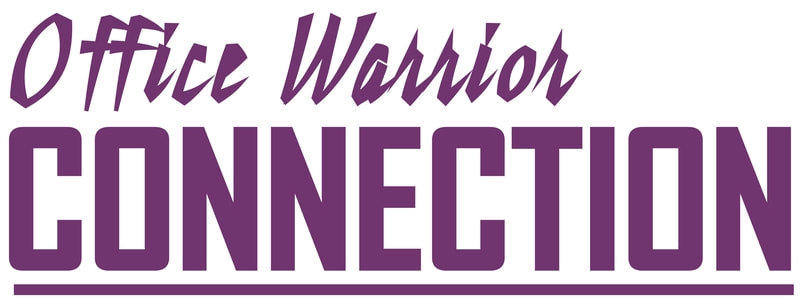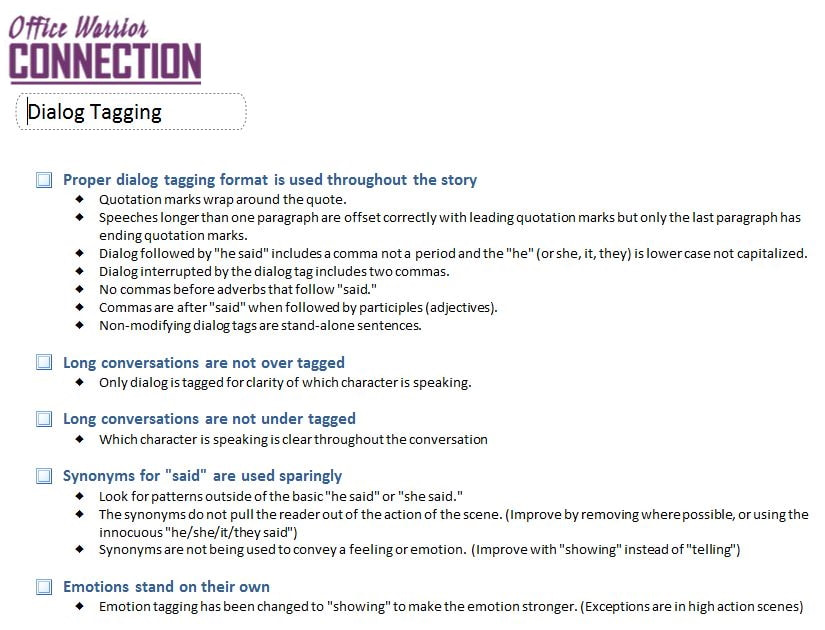|
5/26/2019 Day 26 - Dialog TagsWhat are Dialog Tags? Dialog tags are the "he said/she said" (and all the myriad variations) portion of dialog. The tags provide the attribution of dialog to whomever is speaking. They may occur before, after, or in the middle of speech. What Are the Rules for "Proper" Tagging? I'm going to take a page out of "The Chicago Manual of Style" (CMOS) to talk about the proper construction of dialog tags. However, be aware that what is considered acceptable in writing styles can shift over time. What's proper today doesn't always equate to what is acceptable or what is preferred. Therefore, what I state about dialog tags may not be the most popular stance you find depending on who is presenting the information, what industry they work in, and what year it is. Also worth noting is that I'm writing in the US and there may be stylistic differences for other countries. The key is consistency. If you use a style that is acceptable as opposed to proper, be sure to be consistent in your usage. Even CMOS will say "always" and "never" have no place in this discussion because there are rare exceptions to all kinds of rules. In general, follow the basic rules outlined below, and if there is some compelling reason to break the rule, just be consistent and break it in every instance. So without further ado, here are the CMOS rules for tagging dialog.
Okay, there's no real thing called "emotion tagging." It's just a phrase I came up with for when I'm editing. Emotion tagging is when you use an emotion instead of "said" in your dialog tag or when you use an adverb to modify the verb "said" (or its many synonyms). In my humble opinion, you cannot "emote" a sentence out of your mouth. Just try laughing and talking at the same time. Try humming and talking at the same time. Try smiling and talking at the same time. Okay, maybe you can do that one. Maybe you can sob and talk at the same time too. But I vote to eliminate these type of tags. I say, let the emotion be it's own action. Consider this sentence: "I don't want to leave you," she cried. The question is whether or not she is "crying out" the sentence (which is perfectly acceptable), or whether she is actually crying. If she is crying with tears flowing down her face, why not let that be the action (or "showing" part) of the paragraph or scene. See Day 20 if you want a review of Show or Tell. [link] The sentence, if the character isn't actually "crying out" might be rewritten as: Tears slid down her cheeks. "I don't want you to leave." Technically, yes, both are acceptable. But the second one, depending on the context may have more impact because the emotion stands on it's own as an action. Consider using stronger writing by eliminating emotion tagging. Overuse/Under-use of Tagging How many ways can you say "said?" Stated, mimicked, railed. There are literally hundreds of words that can replace the word said in a dialog tag. We've already talked about eliminating the emotion words, but that will still leave a lot of synonyms for said. I see two opinions about using "said" in dialog tags right now. On one side, a group of people are saying don't use said over and over. Mix it up. Use those synonyms. On the other side, and perhaps a bit more popular, people are saying, just use "said." Said disappears from the page when the reader reads, and all those synonyms slow the reader down. I'm in the second camp. My feeling is that dialog tags should be invisible as much as possible. Therefore, you really only need them to clarify who is the speaker or when you want to express an emotion in the most concise was because you don't want to draw the reader out of an action sequence. In the first case, you can help make those saids disappear by not tagging every line of dialog. By only tagging when you absolutely need to, like in lengthy back and forth discussions, the rest of the saids disappear into the background. Just to keep everyone on the same page and understanding who is speaking, throw in the occasional "he said" or "she said." It also means you don't use the synonym for said unless you want to express a certain emotion in the quickest, most concise way because you don't want to interrupt the flow of dialog. If you use dialog tags with most of your dialog, you are probably over-tagging. If you can't jump right to a section of dialog and tell immediately who is speaking (either because there are no other clues in the dialog, or because too much back and forth has occurred and you've lost track), you are under-tagging. Order of Operation You thought that was a math term, didn't you? Ok, you're right, it is, but I also like to use the phrase when talking about dialog tags because there is a proper place for them when you find you need to use them. The order of operations in writing dialog tags only matters when you aren't using the basic "he said" or "she said." If you want the "he said" tag to be invisible to the reader, put it at the end of the tag. The order is more important when the dialog tag is an action. Does the person laugh, then say something? Or does the person say something, then laugh? Maybe it doesn't matter in some instances, but it will be important in many because it may say something about the person or the emotion they are experiencing based on the action they are performing. In some context, laughing after saying something can be used to disarm an offensive comment or to give a sense of, "I'm just kidding." Laughing before something can mean they are responding to something they saw as funny or outrageous. Laughter can also be used to demean or brush off a comment. The order of operation can be used to provide context in very concise writing. Exercise: Evaluate Your Method of Dialog Tagging
Dialog Tagging Checklist Proper dialog tagging format is used throughout the story
DOWNLOAD: Dialog Tagging Checklist Worksheet Template Instructions Return to the Table of Contents Go to Day 27 - Voice and Tense Comments are closed.
|


 RSS Feed
RSS Feed
